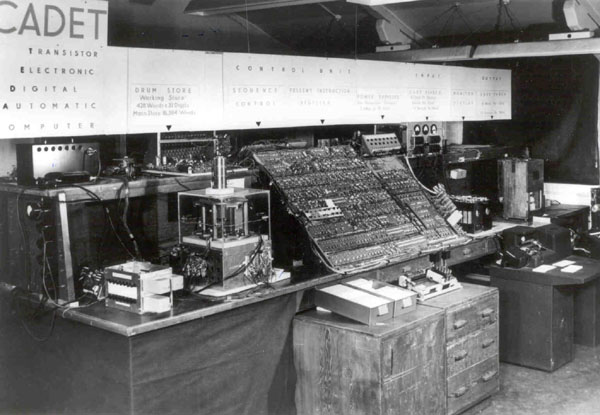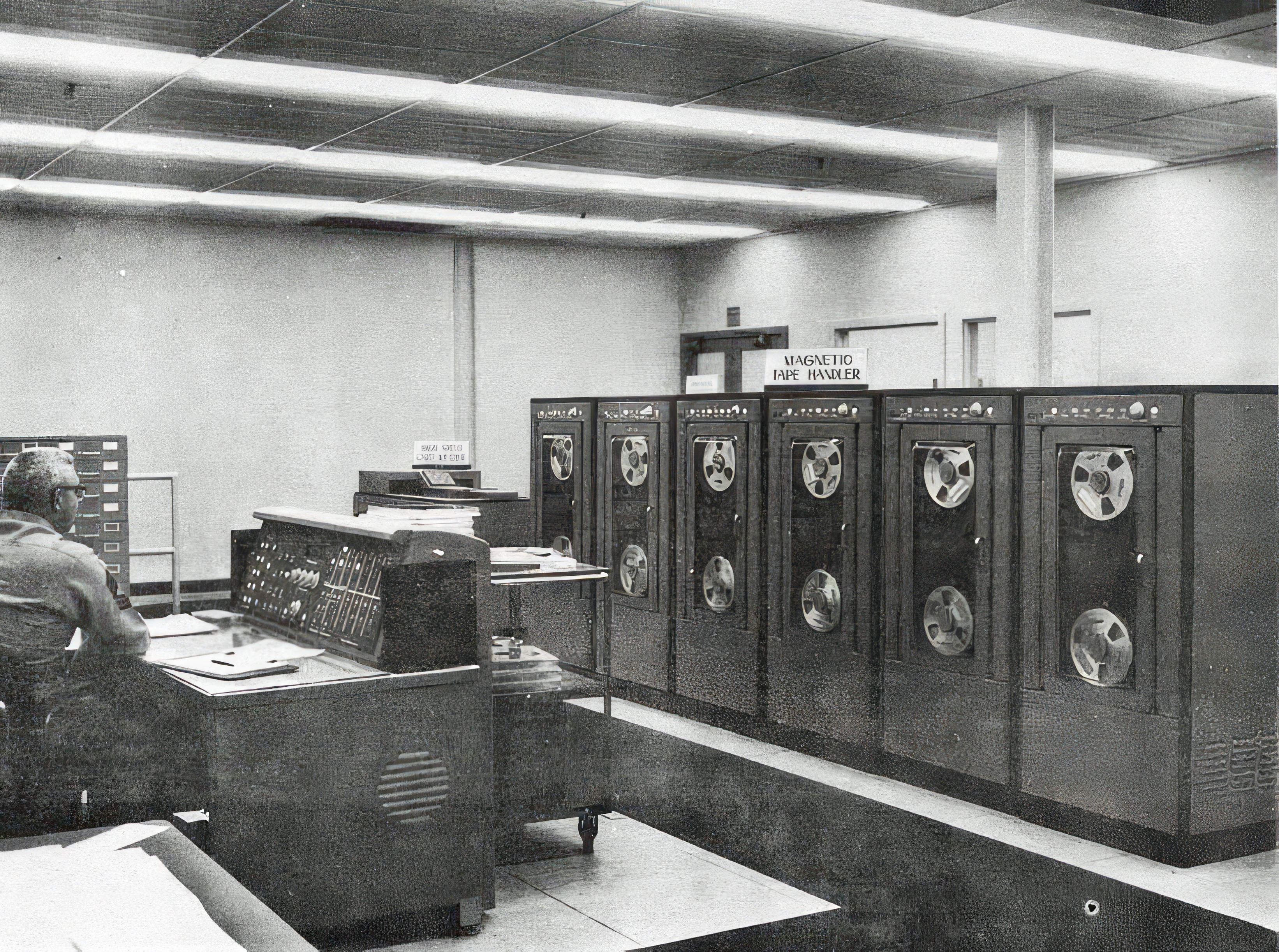List of transistorized computers on:
[Wikipedia]
[Google]
[Amazon]
 This is a list of transistorized computers, which were digital computers that used discrete transistors as their primary logic elements. Discrete transistors were a feature of logic design for computers from about 1960, when reliable transistors became economically available, until
This is a list of transistorized computers, which were digital computers that used discrete transistors as their primary logic elements. Discrete transistors were a feature of logic design for computers from about 1960, when reliable transistors became economically available, until

 *
*
 *
*

 This is a list of transistorized computers, which were digital computers that used discrete transistors as their primary logic elements. Discrete transistors were a feature of logic design for computers from about 1960, when reliable transistors became economically available, until
This is a list of transistorized computers, which were digital computers that used discrete transistors as their primary logic elements. Discrete transistors were a feature of logic design for computers from about 1960, when reliable transistors became economically available, until monolithic integrated circuit
An integrated circuit or monolithic integrated circuit (also referred to as an IC, a chip, or a microchip) is a set of electronic circuits on one small flat piece (or "chip") of semiconductor material, usually silicon. Large numbers of tiny M ...
s displaced them in the 1970s. The list is organized by operational date or delivery year to customers. Computers announced, but never completed, are not included. Some very early "transistor" computers may still have included vacuum tubes in the power supply or for auxiliary functions.
1950s

1953
*University of Manchester
The University of Manchester is a public university, public research university in Manchester, England. The main campus is south of Manchester city centre, Manchester City Centre on Wilmslow Road, Oxford Road. The university owns and operates majo ...
Transistor Computer
A transistor computer, now often called a second-generation computer, is a computer which uses discrete transistors instead of vacuum tubes. The first generation of electronic computers used vacuum tubes, which generated large amounts of heat, ...
1953 (prototype) 1955 (full scale) experimental1954
*Bell LabsTRADIC
The TRADIC (for TRAnsistor DIgital Computer or TRansistorized Airborne DIgital Computer) was the first transistorized computer in the USA, completed in 1954.
The computer was built by Jean Howard Felker of Bell Labs for the United States Air ...
for U.S. Air Force1955
*Harwell CADET
The Harwell CADET was the first fully transistorised computer in Europe, and may have been the first fully transistorised computer in the world.
The electronics division of the Atomic Energy Research Establishment at Harwell, UK built the H ...
demonstrated February 1955, one-off scientific computer1956
*Electrotechnical Laboratory ETL Mark III (Japan) experimental, began development 1954, completed 1956, Japan's first transistorizedstored-program computer
A stored-program computer is a computer that stores program instructions in electronically or optically accessible memory. This contrasts with systems that stored the program instructions with plugboards or similar mechanisms.
The definition ...
*MIT
The Massachusetts Institute of Technology (MIT) is a private land-grant research university in Cambridge, Massachusetts. Established in 1861, MIT has played a key role in the development of modern technology and science, and is one of the ...
TX-0
The TX-0, for ''Transistorized Experimental computer zero'', but affectionately referred to as tixo (pronounced "tix oh"), was an early fully transistorized computer and contained a then-huge 64 K of 18-bit words of magnetic-core memory. Constr ...
* Metrovick 9501957
* BurroughsSM-65 Atlas
The SM-65 Atlas was the first operational intercontinental ballistic missile (ICBM) developed by the United States and the first member of the Atlas (rocket family), Atlas rocket family. It was built for the U.S. Air Force by the Convair Di ...
ICBM Guidance Computer MOD1, AN/GSQ-33 (no relation to Manchester ATLAS)
* Ramo-Wooldridge (TRW) RW-30 airborne computer
*Univac
UNIVAC (Universal Automatic Computer) was a line of electronic digital stored-program computers starting with the products of the Eckert–Mauchly Computer Corporation. Later the name was applied to a division of the Remington Rand company and ...
TRANSTEC, for US Navy
*Univac
UNIVAC (Universal Automatic Computer) was a line of electronic digital stored-program computers starting with the products of the Eckert–Mauchly Computer Corporation. Later the name was applied to a division of the Remington Rand company and ...
ATHENA
Athena or Athene, often given the epithet Pallas, is an ancient Greek goddess associated with wisdom, warfare, and handicraft who was later syncretized with the Roman goddess Minerva. Athena was regarded as the patron and protectress of ...
, US Air Force missile guidance (ground control)
*IBM 608
The IBM 608 Transistor Calculator, a plugboard-programmable unit, was the first IBM product to use transistor circuits without any vacuum tubes and is believed to be the world's first all-transistorized calculator to be manufactured for the commerc ...
transistor calculator (its development was preceded by the prototyping of an experimental all-transistor version of the 604 demonstrated in October 1954), announced 1955, first shipped December 1957
*DRTE Computer
The DRTE Computer was a transistorized computer built at the Defence Research Telecommunications Establishment (DRTE), part of the Canadian Defence Research Board. It was one of the earlier fully transistorized machines, running in prototype form ...
, Canadian experimental system delivered 1957, added parallel math unit and other improvements in 1960.
1958
 *
*Electrologica X1
The Electrologica X1 was a digital computer designed and manufactured in the Netherlands from 1958 to 1965. About thirty were produced and sold in the Netherlands and abroad.
The X1 was designed by the Mathematical Centre in Amsterdam, an acade ...
*TX-2
The MIT Lincoln Laboratory TX-2 computer was the successor to the Lincoln TX-0 and was known for its role in advancing both artificial intelligence and human–computer interaction. Wesley A. Clark was the chief architect of the TX-2.
Speci ...
*UNIVAC Solid State
The UNIVAC Solid State was a magnetic drum-based solid-state computer announced by Sperry Rand in December 1958 as a response to the IBM 650. It was one of the first computers to be (nearly) entirely solid-state, using 700 transistors, and 3000 m ...
("mostly" solid state)
* Philco Transac S-1000 scientific computer- Navy/NSA SOLO, one-off for NSA
The National Security Agency (NSA) is a national-level intelligence agency of the United States Department of Defense, under the authority of the Director of National Intelligence (DNI). The NSA is responsible for global monitoring, collectio ...
*Philco Transac S-2000
Philco was one of the pioneers of transistorized computers. After the company developed the surface barrier transistor, which was much faster than previous point-contact types, it was awarded contracts for military and government computers. Comme ...
electronic data processing computer
* Mailüfterl
*RCA 501
The RCA 501 was a transistor computer manufactured by RCA beginning in 1958.
History
RCA's pioneering work in transistors in other products provided its engineers with the basis needed to design effective use of transistors in early solid-state e ...
intended as a commercial system but used in military applications
* Siemens System 2002 – Prototype in operation since 1956, first machine was put in operation in 1958.
*Autonetics Recomp II The Autonetics RECOMP II was a computer first introduced in 1958. It was made by the Autonetics division of North American Aviation.
It was attached to a desk that housed the input/output devices. Its desk integration made it a hands-on small sys ...

1959
 *
*NCR 304
The NCR 304 computer hardware, announced in 1957, first delivered in 1959, was National Cash Register (NCR)'s first transistor-based computer. The 304 was developed and manufactured in cooperation with General Electric, where it was also used in ...
, announced in 1957, first delivery in 1959
*Olivetti Elea
The Elea was a series of mainframe computers Olivetti developed starting in the late 1950s. The system, made entirely with transistors for high performance, was conceived, designed and developed by a small group of researchers led by Mario Tchou ...
9003
*MOBIDIC
Sylvania's MOBIDIC, short for "MOBIle DIgital Computer", was a transistorized computer intended to store, sort and route information as one part of the United States Army's Fieldata concept. Fieldata aimed to automate the distribution of battle ...
*IBM 7090
The IBM 7090 is a second-generation transistorized version of the earlier IBM 709 vacuum tube mainframe computer that was designed for "large-scale scientific and technological applications". The 7090 is the fourth member of the IBM 700/7000 s ...
(6/60)
*IBM 1401
The IBM 1401 is a variable-wordlength decimal computer that was announced by IBM on October 5, 1959. The first member of the highly successful IBM 1400 series, it was aimed at replacing unit record equipment for processing data stored on pu ...
*IBM 1620 Model I
The IBM 1620 was announced by IBM on October 21, 1959, and marketed as an inexpensive scientific computer. After a total production of about two thousand machines, it was withdrawn on November 19, 1970. Modified versions of the 1620 were used as ...
and successors IBM 1620 Model II
The IBM 1620 was announced by IBM on October 21, 1959, and marketed as an inexpensive scientific computer. After a total production of about two thousand machines, it was withdrawn on November 19, 1970. Modified versions of the 1620 were used as ...
*NEAC 2201 ( NEC)
* EMIDEC 1100
* TRW RW-300
*PDP-1
The PDP-1 (''Programmed Data Processor-1'') is the first computer in Digital Equipment Corporation's PDP series and was first produced in 1959. It is famous for being the computer most important in the creation of hacker culture at Massachusett ...
* Standard Elektrik Lorenz SEL ER 56
1960s

1960
*AEI 1010 *Honeywell 200
The Honeywell 200 was a character-oriented two-address commercial computer introduced by Honeywell in December 1963, the basis of later models in Honeywell 200 Series, including 1200, 1250, 2200, 3200, 4200 and others, and the character processor ...
*Honeywell 800
The Datamatic Division of Honeywell announced the H-800 electronic computer in 1958. The first installation occurred in 1960. A total of 89 were delivered. The H-800 design was part of a family of 48-bit word, three-address instruction format compu ...
first installation 1960
*UNIVAC LARC
The UNIVAC LARC, short for the ''Livermore Advanced Research Computer'', is a mainframe computer designed to a requirement published by Edward Teller in order to run hydrodynamic simulations for nuclear weapon design. It was one of the earlie ...
* CDC 160 (7/60)
*CDC 1604
The CDC 1604 was a 48-bit computer designed and manufactured by Seymour Cray and his team at the Control Data Corporation (CDC). The 1604 is known as one of the first commercially successful transistorized computers. (The IBM 7090 was delivered ...
(1/60)
*Datasaab D2
200px, Datasaab D2 computer at IT-ceum
200px, Front panel
D2 was a concept and prototype computer designed by Datasaab in Linköping, Sweden. It was built with discrete transistors and completed in 1960. Its purpose was to investigate the feasi ...
*DRTE Computer
The DRTE Computer was a transistorized computer built at the Defence Research Telecommunications Establishment (DRTE), part of the Canadian Defence Research Board. It was one of the earlier fully transistorized machines, running in prototype form ...
, expanded version
*Elliott 803
The Elliott 803 is a small, medium-sp